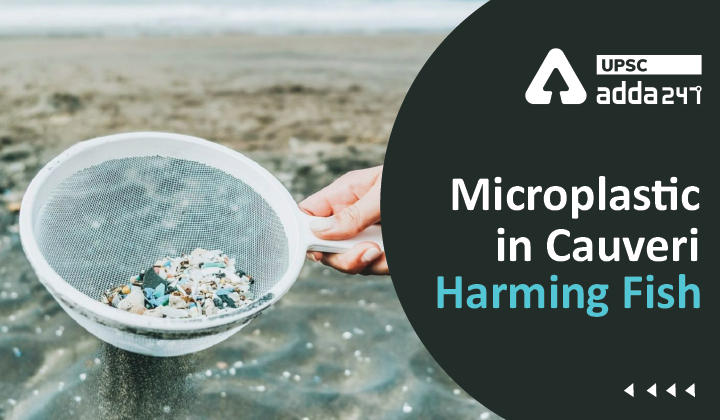Table of Contents
Microplastic pollution UPSC: Relevance
- GS 3: Conservation, environmental pollution and degradation, environmental impact assessment.
Microplastic pollution: Context
- Recently, a new study by the Indian Institute of Science (IISc), Bengaluru revealed that microplastic pollutants may be causing growth defects in fish.
Microplastic pollution in Kaveri: Key points
- Researchers of the study noticed the deformities in fishes and did research on this aquatic species.
- Using a technique called Raman spectroscopy, the researchers detected microplastics and toxic chemicals containing the cyclohexyl functional group.
- A functional group refers to atoms in a compound that determine its chemical properties.
- The researchers treated embryos of the fish with water samples collected from the three sites—fast-flowing, slow-flowing and stagnant—and found that those exposed to water from the slow-flowing and stagnant sites experienced skeletal deformities, DNA damage, early cell death, heart damage, and increased mortality.
- These deformities were seen even after microbes were filtered out, which meant that microplastics and the cyclohexyl functional groups are responsible for the ailments in the fish.
What is microplastics?
- Microplastics are small pieces of plastic, less than 5 mm (0.2 inches) in length, that occur in the environment as a consequence of plastic pollution.
- Microplastics are present in a variety of products, from cosmetics to synthetic clothing to plastic bags and bottles. Many of these products readily enter the environment in wastes.
- They can be classified into two categories based on their origin-
- Primary microplastics: include microbeads found in personal care products, plastic pellets (or nurdles) used in industrial manufacturing, and plastic fibers used in synthetic textiles (e.g., nylon).
- Secondary microplastics: originate from the breakdown of larger plastics. Plastic bottles, bags, fishing nets, and food packaging are some examples of the larger pieces that break down into microplastics, eventually finding their way into the soil, water, and the air we breathe.
- Microplastics are found in several household and industrial products, and chemicals containing the cyclohexyl group, such as cyclohexyl isocyanate, are commonly used in agriculture and the pharmaceutical industry.
कावेरी नदी में माइक्रोप्लास्टिक की उपस्थिति मछलियों को हानि पहुंचा रही है
Impacts of microplastic pollution
On human health
- Human exposure to microplastics is likely to come from airborne dust, drinking water (including treated tap water and bottled water)
- Microplastics can reach our stomach where they can either be excreted, get entrapped in the stomach and intestinal lining, or move freely in body fluids such as blood, thereby reaching various organs and tissues of the body.
- Negatively affects the nervous system, hormones, immune system and have cancer-inducing properties.
On marine ecosystem
- On marine organisms: when consumed, microplastics are stuck in their digestive tracts and also alter their feeding behavior.
- Accumulation of toxic plastics in the stomach leads to starvation and death, resulting in reduced growth and reproductive outputs.
- Magnify marine pollution: by acting as a binding and transporting agent for heavy metals and organic pollutants because of its water-repellent properties.
Microplastic pollution: Solutions
- Reduce, reuse and recycle: this should be the mantra to eliminate the menace of microplastics in the world.
- Ban landfills: Open landfills and open-air burning that are often practiced to manage domestic waste should be banned and replaced with 100% collection and recycling of the used plastics.
- Promote bioplastics as an alternative to microplastics: this can be done by investing in the industry and government support, reducing its cost of production, and enhancing its attractiveness to various industries.
- Awareness generation: among the masses on the lines of Swachha Bharat Mission (SBM), about microplastic derived products, harmful impacts, and ways to reduce its usage should be done on a priority basis.
- A cooperative and collaborative partnership among all stakeholders (the community, industry, government, and civil society organizations) to ensure effective plastic waste management and the subsequent reduction in microplastic pollution.
Read current affairs for UPSC





 TSPSC Group 1 Question Paper 2024, Downl...
TSPSC Group 1 Question Paper 2024, Downl...
 TSPSC Group 1 Answer key 2024 Out, Downl...
TSPSC Group 1 Answer key 2024 Out, Downl...
 UPSC Prelims 2024 Question Paper, Downlo...
UPSC Prelims 2024 Question Paper, Downlo...
